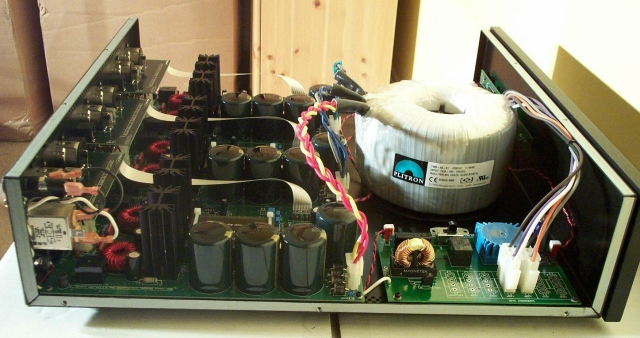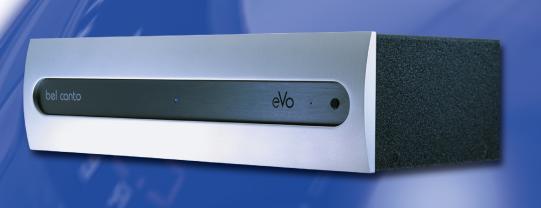Product Review - Bel Canto
Design eVo 200.6 Multi-Channel Digital Power Amplifier - April, 2002
John Kotches, Editor PC/Home Theater
![]()
|
|
Specifications: Channel
Configuration: Three to Six Channels |
|
Bel Canto Design, 212 3rd Avenue North, Suite 345, Minneapolis, Minnesota 55401; Phone: 612-317-4550; Fax: 612-359-9358; E-Mail [email protected]; Web http://www.belcantodesign.com |
A new beginning?
I have come to the conclusion that the next phase of the digital revolution is underway. In this phase, it is the amplifier that is being assaulted by various forms of binary attack. First came the digital revolution for sources, with the emergence of CD. Next, our receiver/preamplifiers are being replaced with digital/analog hybrid components, and now the amplifier too is undergoing this revolution.
We (JJ and I) have already reviewed the digital amplifiers from Sharp. For the current review, I have the digital amplifier from Bel Canto Design, whose eVo 200.2 first came to market in the last days of 2000. This ground-breaking product comes from a company that historically built single-ended triode amplification until that point.
Rather than build unique solutions, the eVo family is currently comprised of identical stereo modules. The eVo 200.2 has one stereo module, the 200.4 has two modules, and the amplifier under review, the 200.6, has three. As appropriate, the power transformer is stepped up to provide the required power for the number of channels.
Each stereo module can be bridged, as is true with more conventional power amplifiers, to provide a higher output mono channel. Because the Bel Canto is a digital amplifier, it is tremendously efficient, with approximately 90% of the draw from the wall deliverable as output to the speakers. Contrast this with an analog amplifier, which is lucky to have efficiency approaching 60% in a Class A/B design, and you can see that digital amplifiers have some great advantages, one of which is that they run cool to the touch. During my entire review cycle, never did the eVo 200.6 get more than a few degrees above ambient temperature. If you're in a northern climate, and expecting some assistance from your amplifier to heat your house, I suggest you steer clear of these amplifiers (for the humor impaired, this is a joke!).
Gutting a digital amplifier . . .
The traditional heft and bulk of an analog amplifier is gone with the Bel Canto. In its place is a much less complicated looking chassis.

You can see from the above picture, that a large portion of the space (roughly 1/3) is taken up by the power transformer. In an analog amplifier of this output, you'd see countless capacitors, resistors, and other assorted traces for each of the six channels.
The eVo series is built from stereo modules, varying
in the number per chassis for the particular model. One of the modules is
shown below. Starting at the left and moving right,
we have the power supply connector to the card, capacitors and resistors, and
the heart of the product, the Tripath digital amplifier module. Past
that, we come to the output transistors with heatsinks, and the output filter.
This is a digital product, so some form of output filtration is required. In
this case it's some capacitors and inductors. At the far right are the
input and output connectors for the channels.
Below is a look at the rear panel. Modular construction allows for lower per-channel prices as the number of modules in the chassis increases, as well as greater economy of scale since the eVo 200.2, 200.4 and 200.6 use common modules. [Click on the picture to see a fully annotated version.]
Each pair of channels is identical, and contains two switches. The first (left switch) selects which connectors are to be used, RCA (single ended) or XLR (balanced). The second (right switch) determines whether the module will operate in stereo or bridged (mono) mode. Bridging is done on a modular basis, so you cannot span modules for bridging. Your available channel options in the 200.6 chassis are 3 (3 bridged output channels), 4 (2 bridged modules, 1 stereo module), 5 (1 bridged module, 2 stereo modules), or 6 (all modules stereo). You can see a pair of single-ended inputs to the outside, and a pair of balanced inputs to the center. Unlike a stereo amplifier, there is no left and right channel designation - they are numbered 1 - 6 instead. In bridged mode, either of the RCA or XLR inputs works.
The speaker binding posts are CE approved, and the colored piece of plastic can be removed, which allows the banana plug to be inserted. For those of you with non-dainty fingers (such as me), it's a bit of a task, but it is for protection from electrical hazards in Europe. Spades are much easier, so if you've got spades, you'll be happy too! When bridged, the farthest left black post and the farthest right red post for any one stereo module are utilized. In stereo mode, conventional connection methods apply. Make sure your speaker cables can be separated enough to connect to the extra wide spacing if you are running in bridged mode.
The front panel has a single toggle switch, a red "standby" indicator, and a blue "power on" LED. If you're going for as dark a theater as possible because you use Front Projection TV, I recommend gaffers tape over the blue LED as it leaves no residue behind.
Click HERE to go to Part 2 - The Sound
![]()
� Copyright 2002 Secrets of Home Theater & High Fidelity
Return to Table of Contents for this Issue.



